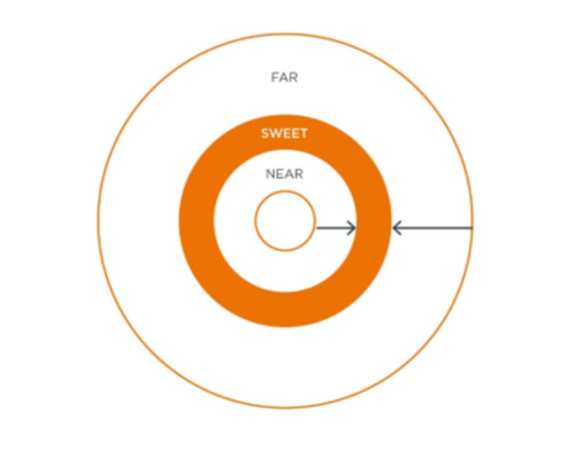From Nano to Mega Sessions: 9 Tips for an Innovation Coach
When SIT started teaching coaches to facilitate internally in their organizations, we taught them to facilitate SESSIONS. But very quickly we realized that this could be– and was –misunderstood, which led us to add the qualifier and coin the expression, still used today, 14 years later: MINI-SESSION. It soon became apparent, though, that even this newly minted term did not solve two opposing but strongly related problems:
1. Plenty of coaches did not dare to assume the responsibility of running a SESSION, even if it was only a MINI session.
And, on the other hand;
2. Quite a few coaches took it upon themselves to run what we could only describe as MAXI or MEGA-SESSIONS, involving up to 50-60 participants, for as much as 2 consecutive days.
Both phenomena have a certain charm, but both pose some serious challenges that merit careful consideration.

Type 1: Not daring to jump in.
We respect these coaches very much for their modesty and responsible approach but are obviously worried that they are not utilizing their new knowledge to its full extent. Conversations and observations show that, in most cases, coaches in this group find it difficult to take the first step for the following reasons:

- They are not sure they possess the skills required to apply the tools successfully;
- They are wary of encountering resistance among their colleagues;
- Their bosses think the course was a waste of time, and therefore do not support them in spending more time on this “extracurricular” activity;
- They are not sure how to translate real-life situations into a script for conducting a mini-session;
- The Coach Training did not build up their confidence to a sufficient degree.
Type 2: Daring to find a cure for cancer and/or achieve world peace
We are obviously impressed with these coaches’ confidence and ambition. We are concerned, though, that the probability of success in these efforts is fairly low, since the coach obviously lacks sufficient skills, experience, and usually also time and resources to perform the task successfully.
Key reasons for this phenomenon are:
- Great enthusiasm at the end of the course, combined with an exaggerated sense of one’s power;
- Pressure from the coach’s boss, who figures if they already invested 3 or 5 days of their associate’s time, they might as well make up for it by getting a huge benefit from their newfound skills;
- The coach training did not indicate clearly enough what the criteria are for selecting a topic, and how to delineate its scope properly.

Rising to this double challenge, here are some helpful tips and recommendations:
1. Remind yourself, your boss, and/or your topic owner that this is a MINI Session, not a maxi-nor mega-session. This means that you do not chew off more than you and the team can swallow (type 2). It also means that you (type 1) can be much more relaxed about taking on the responsibility of facilitating since you are not really facilitating a SESSION, just a MINI session.
2. Very often, we encourage coaches to change the name of the Mini Session and replace it with Micro Session, or even Nano Session. This helps in communicating the correct scope and align expectations.
3. Communication with the coach’s boss is crucial. This can and should be conducted by the SIT trainers, by Corporate Innovation, and by the coach him/herself. Bosses often fail in supporting their coaches by expressing either under- or overwhelming expectations from them. They usually drastically improve in this respect once the situation is pointed out to them.
4. Pay special attention to the exercise of converting a story into a session (read the document as well). Also, we recommend taking full advantage of remote support given to coaches to help them plan sessions.
5. Work both in “pull” and in “push” modes: coaches should be trained to identify opportunities for offering their coaching services and, in parallel, encourage line managers and other stakeholders to turn to coaches and ask for (reasonable) support.
6. Coaches, remember, your first 1-3 or 1-4 or to 5 (depending on your feelings) mini sessions should be
- conducted with a small number of participants, carefully selected to be supportive and constructive in their participation style;
- about a topic you can understand without too much preparation;
- no longer than 3 hours, but also no shorter than 2, so you have time to execute your script properly.
7. Coaches’ supervisors or Innovation Managers: if you want your coach to tackle a relatively large or challenging task, it should definitely not be their first mini session. If you absolutely must challenge them in such a way, make sure you first invent 1-3 small opportunities for them to practice on in order to gain confidence. Don’t hesitate too much – give them whatever small task comes to mind that they can tackle relatively easily.
8. Coaches should work in pairs. A co-coach helps in preparation, offers support during the session, and helps extract learnings after it. The co-coach can and should then also provide hugs, encouragement and – if needed – consolation.
9. A crucial step in preparing a session is defining and sharpening the brief with the topic owner. Special emphasis should be given to the question of scope, so that:
- It does not require knowledge beyond that of the session’s participants, whose number should not exceed (4-6-8 according to the Coach’s experience);
- The topic can be explained in no more than 7 minutes, with a corresponding number of slides;
- The owner can define what kind of results are required, and why they think it is reasonable to achieve them;
- The session is not used to solve a problem that has been tackled repeatedly over the years without success.
In short…
A motivated coach, with a supportive boss and environment, usually develops his/her skills and capabilities swiftly and consistently. But the first steps are crucial. The key is to start out gradually and raise the bar to always be challenged slightly beyond one’s comfort zone. It is the best way to ensure the coach’s personal development and to create valuable results for their managers and colleagues.







